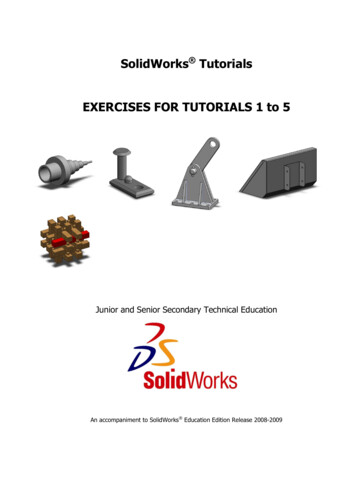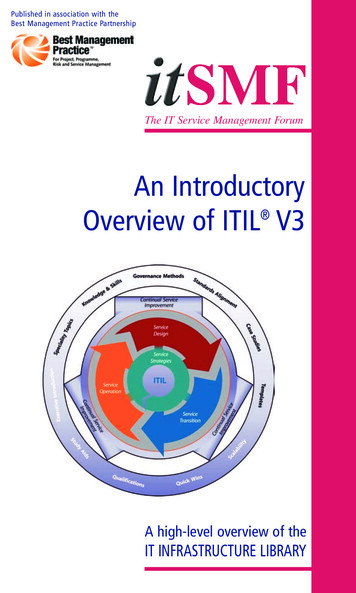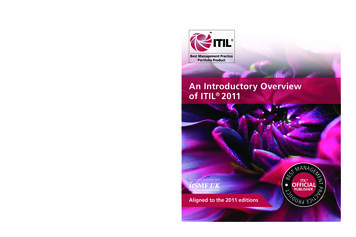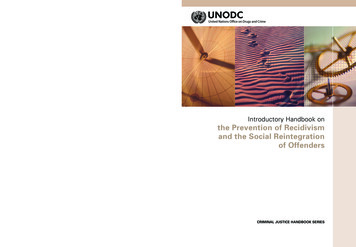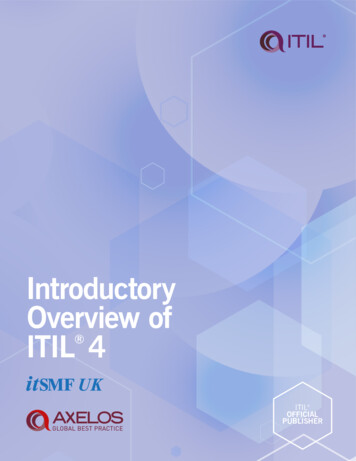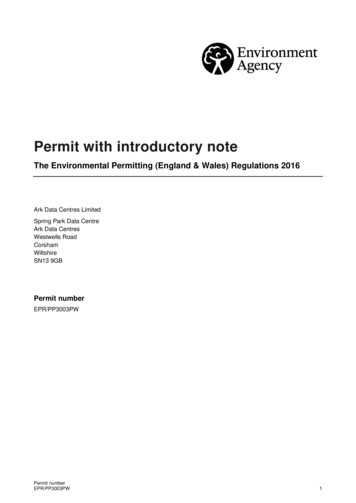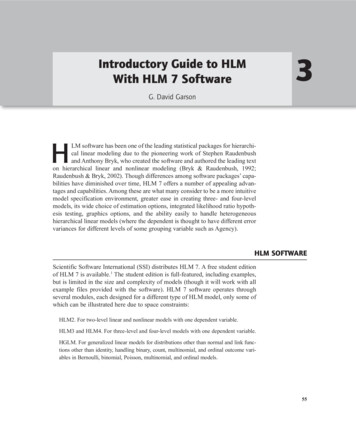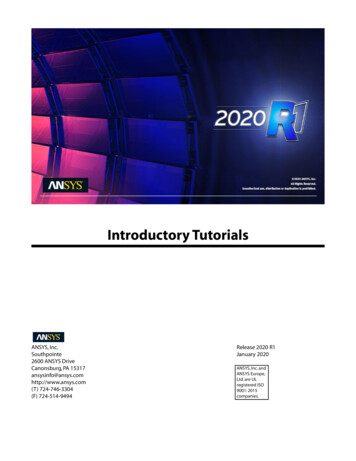
Transcription
Introductory TutorialsANSYS, Inc.Southpointe2600 ANSYS DriveCanonsburg, PA 15317ansysinfo@ansys.comhttp://www.ansys.com(T) 724-746-3304(F) 724-514-9494Release 2020 R1January 2020ANSYS, Inc. andANSYS Europe,Ltd. are ULregistered ISO9001: 2015companies.
Copyright and Trademark Information 2020 ANSYS, Inc. Unauthorized use, distribution or duplication is prohibited.ANSYS, ANSYS Workbench, AUTODYN, CFX, FLUENT and any and all ANSYS, Inc. brand, product, service and featurenames, logos and slogans are registered trademarks or trademarks of ANSYS, Inc. or its subsidiaries located in theUnited States or other countries. ICEM CFD is a trademark used by ANSYS, Inc. under license. CFX is a trademarkof Sony Corporation in Japan. All other brand, product, service and feature names or trademarks are the propertyof their respective owners. FLEXlm and FLEXnet are trademarks of Flexera Software LLC.Disclaimer NoticeTHIS ANSYS SOFTWARE PRODUCT AND PROGRAM DOCUMENTATION INCLUDE TRADE SECRETS AND ARE CONFIDENTIAL AND PROPRIETARY PRODUCTS OF ANSYS, INC., ITS SUBSIDIARIES, OR LICENSORS. The software productsand documentation are furnished by ANSYS, Inc., its subsidiaries, or affiliates under a software license agreementthat contains provisions concerning non-disclosure, copying, length and nature of use, compliance with exportinglaws, warranties, disclaimers, limitations of liability, and remedies, and other provisions. The software productsand documentation may be used, disclosed, transferred, or copied only in accordance with the terms and conditionsof that software license agreement.ANSYS, Inc. and ANSYS Europe, Ltd. are UL registered ISO 9001: 2015 companies.U.S. Government RightsFor U.S. Government users, except as specifically granted by the ANSYS, Inc. software license agreement, the use,duplication, or disclosure by the United States Government is subject to restrictions stated in the ANSYS, Inc.software license agreement and FAR 12.212 (for non-DOD licenses).Third-Party SoftwareSee the legal information in the product help files for the complete Legal Notice for ANSYS proprietary softwareand third-party software. If you are unable to access the Legal Notice, contact ANSYS, Inc.Published in the U.S.A.
Table of ContentsWelcome to the Mechanical APDL Introductory Tutorials . vii1. Start Here . 11.1. About These Tutorials . 11.1.1. Preparing Your Screen . 11.1.2. Formats and Conventions Used . 21.1.2.1. Tasks . 21.1.2.2. Actions . 21.1.2.3. Picking Graphics . 31.1.2.4. Interim Result Graphics . 41.1.3. Jobnames and Preferences . 41.1.4. Selecting a Tutorial . 41.2. Glossary . 52. Structural Tutorial . 92.1. Static Analysis of a Corner Bracket . 92.1.1. Problem Specification . 92.1.2. Problem Description . 102.1.2.1. Given . 102.1.2.2. Approach and Assumptions . 102.1.2.3. Summary of Steps . 102.1.3. Build the Geometry . 112.1.3.1. Step 1: Define rectangles. . 122.1.3.2. Step 2: Change plot controls and replot. . 122.1.3.3. Step 3: Change working plane to polar and create first circle. . 132.1.3.4. Step 4: Move working plane and create second circle. . 152.1.3.5. Step 5: Add areas. . 162.1.3.6. Step 6: Create line fillet. . 162.1.3.7. Step 7: Create fillet area. . 172.1.3.8. Step 8: Add areas together. . 182.1.3.9. Step 9: Create first pin hole. . 182.1.3.10. Step 10: Move working plane and create second pin hole. . 192.1.3.11. Step 11: Subtract pin holes from bracket. . 202.1.3.12. Step 12: Save the database as model.db. . 202.1.4. Define the Materials . 202.1.4.1. Step 13: Set preferences. . 202.1.4.2. Step 14: Define material properties. . 212.1.4.3. Step 15: Define element types and options. . 212.1.4.4. Step 16: Define real constants. . 222.1.5. Generate the Mesh . 222.1.5.1. Step 17: Mesh the area. . 222.1.5.2. Step 18: Save the database as mesh.db. . 232.1.6. Apply Loading . 232.1.6.1. Step 19: Apply displacement constraints. . 232.1.6.2. Step 20: Apply pressure load. . 242.1.7. Obtain the Solution . 252.1.7.1. Step 21: Solve. . 252.1.8. Review the Results . 252.1.8.1. Step 22: Enter the general postprocessor and read in the results. . 252.1.8.2. Step 23: Plot the deformed shape. . 262.1.8.3. Step 24: Plot the von Mises equivalent stress. . 262.1.8.4. Step 25: List reaction solution. . 27Release 2020 R1 - ANSYS, Inc. All rights reserved. - Contains proprietary and confidential informationof ANSYS, Inc. and its subsidiaries and affiliates.iii
Introductory Tutorials2.1.8.5. Step 26: Exit the Mechanical APDL program. . 273. Thermal Tutorial . 293.1. Solidification of a Casting . 293.1.1. Problem Specification . 293.1.2. Problem Description . 303.1.2.1. Given . 303.1.2.2. Approach and Assumptions . 313.1.2.3. Summary of Steps . 313.1.3. Prepare for a Thermal Analysis . 323.1.3.1. Step 1: Set preferences. . 323.1.4. Input Geometry . 323.1.4.1. Step 2: Read in the geometry of the casting. . 323.1.5. Define Materials . 333.1.5.1. Step 3: Define material properties. . 333.1.5.2. Step 4: Plot material properties vs. temperature. . 343.1.5.3. Step 5: Define element type. . 353.1.6. Generate Mesh . 353.1.6.1. Step 6: Mesh the model. . 353.1.7. Apply Loads . 373.1.7.1. Step 7: Apply convection loads on the exposed boundary lines. . 373.1.8. Obtain Solution . 383.1.8.1. Step 8: Define analysis type. . 383.1.8.2. Step 9: Examine solution control. . 383.1.8.3. Step 10: Specify initial conditions for the transient. . 383.1.8.4. Step 11: Set time, time step size, and related parameters. . 403.1.8.5. Step 12: Set output controls. . 403.1.8.6. Step 13: Solve. . 403.1.9. Review Results . 413.1.9.1. Step 14: Enter the time-history postprocessor and define variables. . 413.1.9.2. Step 15: Plot temperature vs. time. . 423.1.9.3. Step 16: Set up to animate the results. . 423.1.9.4. Step 17: Animate the results. . 433.1.9.5. Step 18: Exit the program. . 444. Electromagnetics Tutorial . 454.1. Magnetic Analysis of a Solenoid Actuator . 454.1.1. Problem Specification .
THIS ANSYS SOFTWARE PRODUCT AND PROGRAM DOCUMENTATION INCLUDE TRADE SECRETS AND ARE CONFID-ENTIAL AND PROPRIETARY PRODUCTS OF ANSYS, INC., ITS SUBSIDIARIES, OR LICENSORS.The software products and documentation are furnished by ANSYS, Inc., its subsidiaries, or affiliates under a software license agreement
